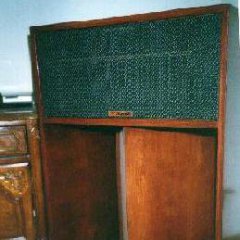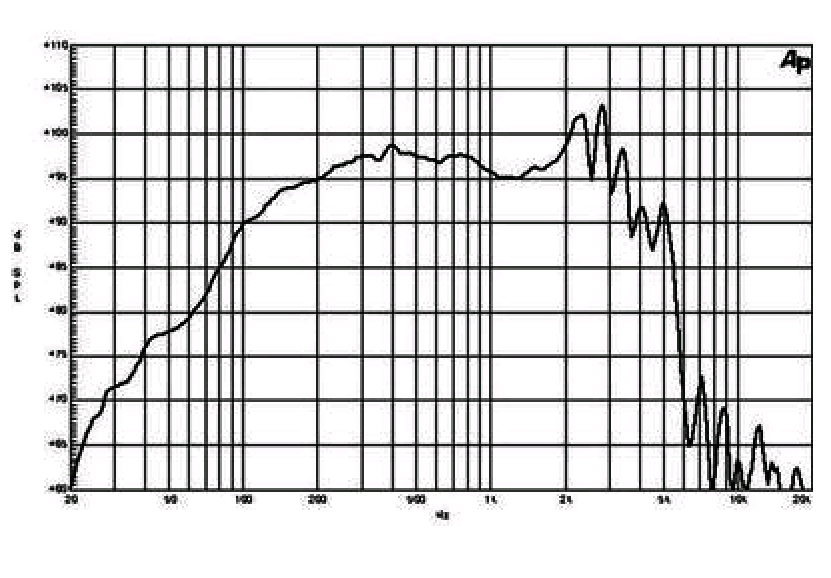-
Posts
5891 -
Joined
-
Last visited
-
Days Won
1
Content Type
Forums
Events
Gallery
Posts posted by JohnA
-
-
Did/does Klipsch make a reasonable center channel match for Heresies? Academy?
-
 1
1
-
-
That sounds like amplifier clipping. However, open the back and check/clean the connections to the crossover and drivers.
If that doesn't change anything, swap speakers from one channel to the other.
If that doesn't change anything, swap squawkers from one speaker to the other.
If that doesn't change the sound, the problem in in the crossover.
-
-
You've got my speakers. They were sold on the Nashville Craigslist and my brother picked them up for me. I bought them to be used at events at my church. That surely means "Audio Systems" was the one on 23rd Ave N in Nashville, TN.
-
On 2/2/2021 at 7:17 AM, Retrograde said:
Gosh.... Only had mine for ten months... Hope I don't get the upgrade fever... 😷
I would say there will be an upgrade kit for the IIIs before long. The changes are limited enough to be easy.
-
 5
5
-
-
Yeah. Cool. He has a point, but maybe overstated.
I'm unsure of the effect all that has on tube amps, but its a lesser problem with solid state. A SS amp *simulates* a voltage source at most power levels. That is, it boosts input voltage by x and supplies whatever current the speaker *draws* at the voltage applied to it. It is a valid speaker design technique to use a lower impedance driver to make up for a little lower sensitivity. Early Cornwalls are an example; the 4 ohm woofer *draws* extra power so it can keep up with the squawker and tweeter. A practical speaker design has limits on this trick and I'd say Heresy 1s push that limit with about 128 ohms in the midrange. In its case the higher impedance in the midrange *draws* (impedes current flow) less current (and power) so the 107 dB squawker is not too loud.
-
 2
2
-
-
On 1/30/2021 at 6:11 PM, MRych said:
I have recently upgraded to 820f floor speakers, running off a Yamaha RX-A780 receiver. I was thinking about adding a amp for the towers??
Is this a good idea?? If so, what amp options should I look at.
It won't hurt. It might help. Unless you like AC/DC at full concert volume, it isn't necessary. I wouldn't bother, I would live with the Yamaha, or upgrade to a better unit ($$$$). Generally, you'll get the best sound and greater flexibility with all separates.
You need to double your power rating to hear a small, noticeable difference in volume; 200 wpc. Ten times the power will be a big, obvious difference in volume; 1000 wpc. Better quality amps usually have higher damping factors and that extra control of the woofer will be noticeable. Other details and delicacies in the music are a function of the amp's build quality and design and a much harder thing to quantify. Again, $$$$.
-
Watco Danish Oil will give a nice color and light protection. Follow that with a coat of Boiled Linseed oil in a few days. After 3 or 4 days rub that lightly with fine steel wool for a satin finish.
-
Bonjour!
Just about your only option is a Crites CW1228 Woofer. I am pretty sure the K-31 has been discontinued.
https://critesspeakers.com/prices-other_stuff.html
You can also try eBay.com.
Traduction par Google.
À peu près votre seule option est un woofer Crites CW1228. Je suis presque sûr que le K-31 a été abandonné. https://critesspeakers.com/prices-other_stuff.html
Vous pouvez également essayer eBay.com.
-
Nice! It should be played daily!
-
 1
1
-
-
On 1/28/2021 at 5:55 PM, moray james said:
...... K43 does not play as low but takes way more power. Pick what you like, as always YMMV.
Originally that statement was applied only to a Klipschorn. Since a La Scala can hardly get below 50 Hz, less low end would not be noticed.
-
In a 1000 sq ft (y'all still use sq ft?) you should only need 2 or 3 Heresies. In such a random environment, stereo will not be useful. Imagine each speaker is a flood light and "light" the space as evenly as reasonable.
A local Chattanooga restaurant with a retro flavour has vintage audio gear behind the bar, including an open reel deck with 10.5" reels turning. Enthralled, I went to look. There was no tape and no signal in the VU meters. I was disappointed, but the look was perfect!
-
You have the best drum reproduction speaker available!
-
You said, "they". Do you have 2 Shorthorn Model Ts?
I was once looking for a Shorthorn Model S, because Model Ts were/are unobtanium. The last time I saw a Model S sell it went over $400. I'm sure you ought to get that and possibly $600.
-
I would look at Forte. Any Klipsch would work, but the larger ones will take up too much floor space in your smallish room.
Since the room is square, you can expect room resonances to be prominent. Try putting your electronics in a corner and the speakers along each wall a few feet out of the corner.
-
 1
1
-
-
I have an interest in SWL. I've been looking at receivers and antennae with no conclusion, yet.
I'm interested I. News and information from abroad, plus some music, maybe. Experience with a small portable has not been too good. Its reception is poor and noisy.
"Are you experienced?" I'd prefer a table top radio under $500, but it needs to be straightforward to use. Where is a good directory/schedule of broadcasts?
I've got an app for Internet listening, but it is not pick a broadcast and listen. There is always some fiddling, or the broadcast is just not there.
-
If you call Eminence with that 67- number, they'll tell you what it was made for.
-
 1
1
-
-
OK, remember, these are ratings with an associated distortion spec, not necessarily max output at clipping. In this simplistic situation, the power supply would appear to be limited to 5.5 amps and that is with a significant voltage sag.
Following the formulas, Pwr = I x V and V = I x R the amp will deliver all the current (I) the Resistance (impedance) will allow, pushed by the Voltage set by the volume control, up to the 5.5 amp limit, regardless of the impedance. At many points, it would certainly be 2x the power that the same voltage would push through 8 ohms, as long as you stayed below 5.5 amps. That might even be 4x the power if you had a 2 ohm load (and stayed under thermal limits and 5.5 amps).
Remember, voltage pushes, impedance restricts and current causes heat. Kept within safe limits, any amp will almost double current into half the impedance. No amp is so linear that it doubles when driven at its limits.
-
 2
2
-
-
In 1977, the primary Klipsch dealer in Nashville was Audio Systems, off Elliston
Place, and that was where I first heard Klipsch. They were astonishing! One demo was a quad setup with K-horns in the front and Belle Klipsch as rears. It recreated the sound I'd recently heard in the Nashville Municipal Auditorium in a completely believable way! It started my Klipsch journey.
I think I still have an Audio Systems reciept from that era.
Rumour had it that Nicholson's Hi-Fi carried Klipsch after Audio Systems died.
-
 2
2
-
-
I like a thin wire silver solder I got years ago at Radio Shack. I use it because it has a higher melting point, in case the joints heat a little at high power.
-
On 12/28/2020 at 9:17 AM, Klipschguy said:
Why does the Cornwall use a 2.5mH inductor in its 1st order networks for a 600hz crossover point? A 2.5mH choke used with a 4 ohm woofer (like the K33) corresponds to a crossover point of about 250Hz.
My understanding is the Cornwall has a hole in its frequency response from about 400 to 600Hz. Intuitively, I would think the woofer would be crossed over higher to compensate for the sagging response. I guess the hole in the frequency response could be caused by an internal standing wave where a different choke might not do much, but I am scratching my head a little bit over this one.
The inductor must make the speaker's response flat. Look at the attached response curve that is typical of many woofers. Setting the *calculated* (electrical) crossover lower will make the actual acoustic crossover higher and where you want it. There is both art and science in speaker design and the crossover is not a separate part.
Since when did a Cornwall have a "hole" in its response?
-
I run a Heresy of similar vintage with a crossover similar to the Type AA in my La Scalas. They have solder terminal K-55-Vs, same as my La Scalas. Not perfect, but only I seem to notice.
-
What *I* would do (and have done) is to replace the caps with the best film and foil caps my wallet would tolerate, swap out the squawkers for solder terminal K-55-V (or Allen A-55Gs) and leave the crossover points alone. The reason is, both the K-77-* and DE-120s have a response hump that the AA tweeter circuit smooths out. If you change the tweeter circuit, you will have trouble replicating that built-in EQ. To help with phasing and driver overlap, you can add an inductor to the squawker circuit to make it a bandpass. With the DE-120s you can defeat/remove the KLiP diodes in the tweeter circuit. You can also physically align the tweeter and squawker voicecoils by placing the tweeter on top of the cabinet. That is the largest time misalignment in the system. I have not done it, but a large gauge woofer inductor, perhaps even an air-core, *might* increase the woofer's output a tinch, at the risk of changing the woofer/box/horn "Q" and slightly changing its frequency response.
If your squawkers seem too loud, you have a room problem you should address. Mine tested +/- 4 db in my old theater room and did not have a midrange emphasis.
Attached is my actual schematic. I am using Hovland Musicaps. The .35 uH inductor is an air-core. I moved the tweeter circuit input in front of the squawker cap 20+ years ago because it is "traditional" design and I didn't fully understand how Mr. Paul's design worked. Taking the tweeter off after the squawker cap adds a "knee" in the tweeter curve giving additional protection to the tweeter from bass notes.
-
Related to Ashley?
I would think you haven't properly switched from Bluetooth to analog in. Those sorts of things seem to prefer bluetooth.






Cornwall and Heresy maintenance
in General Klipsch Info
Posted
i believe you can get proper replacement gaskets at critesspeakers.com.